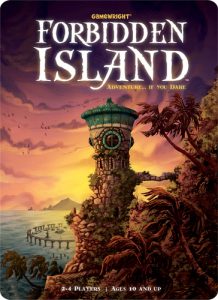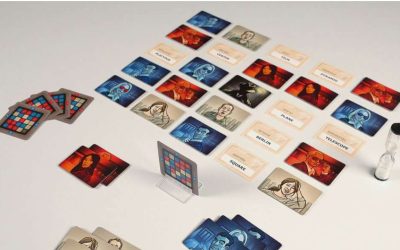Introduction To Cooperative Board Games

Most of us have a competitive streak…
Traditionally speaking, the standard goal of game play has been to meet a challenge or an opponent and, using wits, cunning or strength, emerge victorious. Games are a rehearsal for life, so to speak. The beauty of board games is that they let us experience the thrill of competition in a safe environment with no real-world consequences (other than a bruised ego, perhaps). However, what if you enjoy the social aspect of board gaming but aren’t keen on the concept of competition? For some players, competition and anxiety go hand in hand, so they’d rather avoid it altogether. If that sounds familiar to you, let me introduce you to the world of cooperative games.
In a cooperative game, everyone plays together in order to achieve a goal or victory condition. Players win or lose as a group. Because of this, the key components of cooperative games are often communication and team work. In many cases, players share information, cards or strategies with the group and are encouraged to make decisions collectively. This makes for a unique experience, both socially and strategically.
Cooperative games are a relatively new addition to the world of board games, but their game mechanics have quickly become one of the most popular. Early versions of cooperative games were introduced by parents and teachers in education settings during the 1970s. More mainstream titles followed during the 1980s with games like “Scotland Yard” and “Fury of Dracula”. The 1990s and 2000s saw the introduction of games like “Arkham Horror” and “Lord of The Rings”, which took the idea of cooperative play even further. Undoubtedly the biggest success for a cooperative game came in 2008 with the release of ‘Pandemic.’ It is considered the most influential of its genre, and its elegant design has provided inspiration for many of the current cooperative games.
“Pandemic” is a game by Matt Leacock for 2-4 players. The game board depicts a map of the world where several diseases have broken out. The players take the roles of infectious disease specialists who have to work together in order to eliminate and cure the plagues. During their turns, players use actions to travel between cities, treat infected populaces, discover cures or build research stations. After each turn, the game introduces a new challenge by way of an infection deck. Players draw from the deck and each card reveals a newly infected city or an outbreak in cities already infected. You and your team get the feeling you’re playing against an actual opponent that randomly changes and constantly resists the team’s progress.
Most well-designed cooperative games are a real challenge, and that’s a good thing in my opinion. One would likely lose interest in a game that was easy to beat. The thrill comes from getting closer to victory with each round of play. You’ll want to try again to see if you can do better the next time. Even after you have beaten the game, there is often a variant offered for experienced players that makes the game more challenging.
Following the success of “Pandemic”, Matt Leacock also designed “Forbidden Island” and “Forbidden Desert” Both use a game mechanic similar to “Pandemic” but are a little easier to learn and to master. The themes are also less gloomy. In “Forbidden Island” players try to escape a sinking island before it is swallowed by the sea. “Forbidden Desert” challenges the team to escape a desert before the sand dunes take over. These are great options for anyone wanting to experience a cooperative game for the first time, or who would like to introduce the game to children.
Another great game, which provides a very different cooperative experience, is “Hanabi” by Antoine Bauza. In this card game for 2-5 players, the group attempts to play their cards to the middle of the table organizing them by colour and ascending numerical order from 1 to 5. The challenge lies in the fact that, since each player holds their cards facing away from them, you can see everyone’s cards but your own. Communicating the appropriate information about someone else’s cards is the key to winning.
What if you like dexterity games? Well there is a cooperative game for you too. “Menara” by Sébastien Caiveau is a tower building game for 1-4 players. As a group, players have to build a structure out of wooden pillars, reaching a predetermined height in order to succeed. During their turn, each player reveals an action card and tries to fulfil the action it describes. This could include moving pillars to a new location, adding new ones or even re-arranging entire levels. If a player can’t do it, a new level is added to the victory condition. This is one of those games that builds excitement and, unlike Jenga for example, results in other players cheering you on when you try to balance a new piece on a shaky structure.
Today we have an endless supply of cooperative board game choices for both children and adults. They range in complexity and difficulty and offer themes from group adventure games to puzzles and dexterity games, all within the context of working together. I strongly encourage you to give one of them a try.
Are you intrigued to try a cooperative game? Here are my top suggestions:
‘Spiel Des Jahres’ Winners 2021
Arguably the most important event with regards to the world of board gaming is ‘Das Spiel,’...a fair that is held each October in the German city of Essen. Exhibitors and guests from all around the world gather for 4 days to present and try all of the new and exciting...
Word Guessing Games
The philosopher Friedrich Nietzsche once said:...“All I need is a sheet of paper and something to write with, and then I can turn the world upside down.” Even though I am almost certain that he did not say this with regards to board games, part of me wonders and...
The History of ‘Ticket to Ride’
What defines a great board game?...It is its theme, the accessibility and elegance of the rules, the design and production of the components, the depth of strategy, or the level of enjoyment one experiences when playing it? I believe it is a combination of all of...






